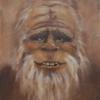 Submitted by Harry on
Submitted by Harry on

Derivative Images
What happened during Vietnam War nobody talks about today? Good question. It’s not entirely uncommon for soldiers returning from war to come home with stories of seeing a monster. Throughout history, plenty of wartime monster sightings have been reported. However, one sighting in particular, or more accurately, multiple sightings, seems to have been more documented than most. This is the case of the Rock Apes of Vietnam.
“Rock Ape” is the name given to creatures allegedly spotted by multiple American soldiers during the Vietnam War. However, even prior to the war, stories floated around of “jungle people.” These jungle people were bipedal and ape-like, standing about six feet tall. They were stoutly built and very muscular, but had protruding stomachs. Like many unknown ape-like creatures, they were also covered in hair, either brown or black, with the exception of their knees, the soles of their feet and hands, and their faces, which were all hairless.
The jungle people tended to live in more isolated, remote areas of the jungle, keeping to themselves. However, if a human made the unfortunate mistake of crossing their path, they would become bold and aggressive, and would not have any hesitation in attacking the unlucky intruder. The jungle people were at their most active at dusk or during the night, and if they traveled, they would do so in packs. This fact would explain some aspects of the sightings later reported by American soldiers.
This particular unit was taking a rest when the trees about 15 yards uphill from them suddenly began to shake violently. Naturally, given their environment, the soldiers assumed the shaking was caused by the enemy, and that they needed to immediately prepare to be under attack. However, as the soldiers watched the trees, they saw “that an oblong head with a face covered in reddish hair and possessing a huge mouth and dark, deep set eyes had emerged from the brush,” according to Brent Swancer
When this bizarre creature fully emerged, the soldiers were able to get a better look, and they saw that it was about 5 feet tall and very muscular, and covered in matted reddish hair. The creature stood on two legs and examined the soldiers just as they examined it. As the soldiers argued over whether or not the creature might be an orangutan, it retreated back into the jungle.
Another incident occurred in 1966, in a location known as Hill 868 in Quang Nam Province, the home of several Rock Ape sightings throughout the war. In this account, a Marine unit was reporting to their captain that they had spotted movement in the brush, which they assumed was being caused by Viet Cong. The captain told his unit over the radio not to fire. Not long after, the unit reported back that, rather than Viet Cong, they were being surrounded by hairy, bipedal humanoid creatures.
The captain told the unit that rather than firing on the creatures, they should instead throw rocks. However, this backfired, as the creatures began throwing the rocks back at them. At this point, the Marines guessed there were hundreds of these creatures, far too overwhelming an amount to stick with their current plan.
The Marines were told to change tactics and use their bayonets to fight the creatures. Soon after the order was given, the captain heard over the radio what sounded to him like an epic battle. Afterwards, men were sent out to investigate. The location was covered with injured—but not dead—Marines as might be expected, but also allegedly the bodies of several Rock Apes. This became known as the Battle of Dong Den, though the only evidence of the event and the dead Rock Ape bodies littering the battlefield seems to be eyewitness accounts, as with most alleged cryptid sightings.
Yet another account comes from an unnamed GI. This man gives a description of the Rock Ape he encountered, which like the other accounts, was recorded in Jorgenson’s book. The GI said, “An oblong head framed the hair-covered face. Dark, deep-set eyes lay beneath a prominent brow, and they did nothing to complement the heavy jowls and angry mouth.”
In 1970, Dr. John MacKinnon claimed he had found tracks that had been identified by locals as coming from the “Batutut,” an entity in Vietnamese folklore resembling the Rock Apes. The tracks had “human looking toes, but being around the size of those of an Asiatic black bear, which are not native to Vietnam.”
In 1974, Professor Vo Quy of the Vietnam National University led a North Vietnamese scientific expedition. The expedition found prints that were described as “wider than a human print but too large to be that of an ape.”
What makes the recorded sightings of Rock Apes unique is that these accounts are generally published in books about the Vietnam conflict that feature veterans recounting their experiences, and not in books that focus on cryptozoology. Perhaps this is why most Rock Ape theories consider natural explanations rather than cryptozoological ones.
The most common theory is that the soldiers actually saw Tonkin snub-nosed monkeys. However, these monkeys do not come near to fitting the descriptions given by the witnesses. Other suggestions for misidentified animals are Barbary Macaques, gibbons, or giant orangutans. Of course, given the mysteriousness of the creatures sighted, more unusual explanations have been given. Some have suggested that Rock Apes could be a surviving population of hominids or early ancestors of humans, or even a surviving population of Gigantopithecus. Others have suggested that they are an undiscovered species of primate.
Jim Newgate
https://www.quora.com/What-happened-during-the-Vietnam-War-that-nobody-talks-about-today
- 308 reads